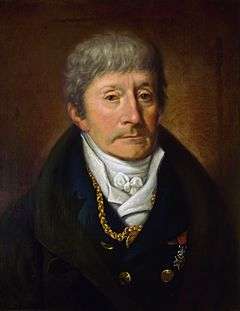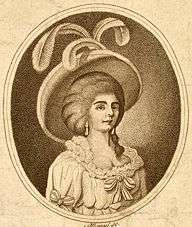La cifra
La cifra is an opera by Antonio Salieri in two acts, set to an Italian libretto by Lorenzo Da Ponte.
| Antonio Salieri |
|---|
 |
|
Operas
|
The work, a dramma giocoso, is set in Scotland, and was written for Adriana Ferrarese del Bene, the first Fiordiligi in Mozart's Così fan tutte.[1]
Performance history
The opera was first performed in Vienna on 9 December 1789. This was followed by a production in Dresden on 13 October 1790. It went on to receive several productions both in Germany and Austria between 1789 and 1805.[2]
La cifra received a recent performance in Cologne in June 2006, in a production conducted by Martin Haselböck and directed by Christian Stückl.[3] In August of 2018, Dell’Arte Opera Ensemble performed La Cifra at La Mama as part of that summer’s Mozart and Salieri Festival. It was the opera’s North American premiere.
Roles
| Cast | Voice type | Premiere, 9 December 1789 (Conductor: - ) |
|---|---|---|
| Eurilla | soprano | Adriana Ferrarese del Bene |
| Lisotta, the daughter of Rusticone | soprano | Bettina Colombati |
| Milord Fideling | tenor | Francesco Bussani |
| Sandrino, the future groom of Lisotta | bass | Paolo Mandini |
| Rusticone, mayor and hotel owner | bass | Francesco Benucci |
| Leandro, friend of Milord Fideling | tenor | Girolamo Cruciati |
Brief Synopsis

Fideling, a Scottish lord, is seeking a lost noblewoman with whom he had fallen in love. Lisotta, the daughter of the town's mayor is betrothed to Sandrino, but is in love with Fideling and believes herself to be the woman he is searching for. Eurilla also loves Fideling but despairs because she is a mere shepherdess. In Act II, before her true identity is revealed, she sings 'Alfin son sola … Sola e mesta' (In the end I am alone... Alone and sad). It finally emerges that Eurilla is in fact the daughter of a nobleman. She and Fideling are reunited and all ends happily in the finale.[4]
Recordings
There is no known studio recording of the complete opera, However, The Salieri Album, (Cecilia Bartoli with the Orchestra of the Age of Enlightenment, conducted by Ádám Fischer, Decca 475 100-2) has two excerpts:
- 'E voi da buon marito … Non vo’ gia che vi suonino' (Lisotta's recitative and aria from Act I)
- 'Alfin son sola … Sola e mesta fra tormenti' (Eurilla's recitative and rondo from Act II.
References
- Glasow, E. Thomas, 'Cecilia Bartoli: The Salieri Album (review)', The Opera Quarterly, Volume 20, Number 2, Spring 2004, pp. 339-341
- 'Die Oper in Italien und Deutschland zwischen 1770 und 1830', Das Opernprojekt Archived 2011-07-19 at the Wayback Machine, University of Cologne (accessed 26 June 2007)
- Schwering, Markus, 'Das ist ein Mozart fürs Volk', Kölner Stadt-Anzeiger, May 30, 2006 (accessed 26 June 2007)
- Liner notes for The Salieri Album (Decca 475 100-2)